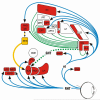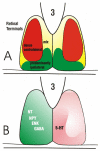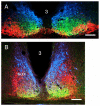Neuroanatomy of the extended circadian rhythm system
- PMID: 22766204
- PMCID: PMC3498572
- DOI: 10.1016/j.expneurol.2012.06.026
Neuroanatomy of the extended circadian rhythm system
Abstract
The suprachiasmatic nucleus (SCN), site of the primary clock in the circadian rhythm system, has three major afferent connections. The most important consists of a retinohypothalamic projection through which photic information, received by classical rod/cone photoreceptors and intrinsically photoreceptive retinal ganglion cells, gains access to the clock. This information influences phase and period of circadian rhythms. The two other robust afferent projections are the median raphe serotonergic pathway and the geniculohypothalamic (GHT), NPY-containing pathway from the thalamic intergeniculate leaflet (IGL). Beyond this simple framework, the number of anatomical routes that could theoretically be involved in rhythm regulation is enormous, with the SCN projecting to 15 regions and being directly innervated by about 35. If multisynaptic afferents to the SCN are included, the number expands to approximately brain 85 areas providing input to the SCN. The IGL, a known contributor to circadian rhythm regulation, has a still greater level of complexity. This nucleus connects abundantly throughout the brain (to approximately 100 regions) by pathways that are largely bilateral and reciprocal. Few of these sites have been evaluated for their contributions to circadian rhythm regulation, although most have a theoretical possibility of doing so via the GHT. The anatomy of IGL connections suggests that one of its functions may be regulation of eye movements during sleep. Together, neural circuits of the SCN and IGL are complex and interconnected. As yet, few have been tested with respect to their involvement in rhythm regulation.
Copyright © 2012 Elsevier Inc. All rights reserved.
Figures







References
-
- Abrahamson EE, Leak RK, Moore RY. The suprachiasmatic nucleus projects to posterior hypothalamic arousal systems. Neuroreport. 2001;12:435–440. - PubMed
-
- Abrahamson EE, Leak RK, Moore RY. The suprachiasmatic nucleus projects to posterior hypothalamic arousal systems. Neuroreport. 2001;12:435–440. - PubMed
-
- Abrahamson EE, Moore RY. Suprachiasmatic nucleus in the mouse: retinal innervation, intrinsic organization and efferent projections. Brain Research. 2001;916:172–191. - PubMed
-
- Aioun J, Chambille I, Peytevin J, Martinet L. Neurons containing gastrin-releasing peptide and vasoactive intestinal polypeptide are involved in the reception of the photic signal in the suprachiasmatic nucleus of the Syrian hamster: an immunocytochemical ultrastructural study. Cell Tissue Res. 1998;291:239–253. - PubMed
-
- Albers HE, Ferris CF. Neuropeptide Y: role in light-dark entrainment of hamster circadian rhythms. Neuroscience Letters. 1984;50:163–168. - PubMed
Publication types
MeSH terms
Grants and funding
LinkOut - more resources
Full Text Sources
Other Literature Sources
Research Materials
Miscellaneous

